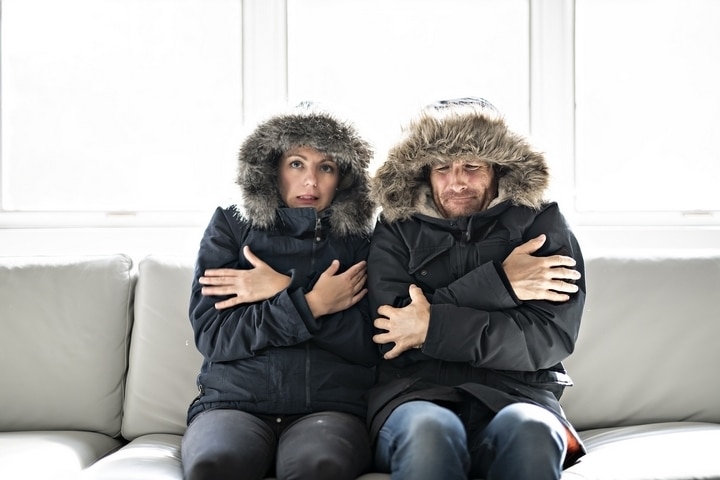Uneven temperatures can make your home feel extremely cold in January and overly hot in July. In most cases, the culprit is a fault or an inefficiency in your HVAC system. Uneven temperatures can manifest in a freezing basement, insufficient airflows in upper rooms, or a kitchen that’s always too warm.
You deserve to be comfortable in your own home. However, these fluctuating temperatures could be inconvenient, frustrating, and may even lead to illnesses. To help you diagnose the problem, a HVAC professional can inspect your systems and perform the proper maintenance that will restore the temperature in your home.
What causes these uneven home temperatures? Why do your rooms feel too warm in one place and too cold in another location? To help you demystify the mystery of uneven temperature in houses, here are seven of the most common causes:
1. Blocked vents & ducts

Blocked vents and ducts are among the common causes of uneven temperature in houses. Over time, your ventilation and ductwork will accumulate dirt, dust and hair, all of which can obstruct the distribution of temperature in your home. Fortunately, these problems could be fixed by thoroughly cleaning the HVAC systems. As part of your home maintenance tasks, always schedule for a duct and vent cleaning at regular intervals.
In other instances, there may be misplaced furniture, appliances or home fixtures that block the airflow into your rooms. You should inspect each vent around your home to ensure the airflow is unobstructed. If there is a section of the room that feels too warm or too cold, you can open the vents and tilt them in a way to redirect the airflow at the desired direction.
During autumn, this is a good time to perform a duct inspection. You can ensure there are no blockages, allowing the air to flow through your ducts properly. In addition, you may detect leaks, corrosion, or other related problems in the ductwork, which requires further HVAC maintenance before the winter season arrives.
2. Poor insulation

It’s difficult to regulate temperatures in a house with poor insulation. The insulation could be compromised by its age or a sloppy installation process performed by an unskilled individual. Many homeowners believe that they could insulate the HVAC systems by themselves. Unfortunately, their DIY efforts often result in poorly fitted insulation that allows air to escape through the ductwork.
When you are inspecting the status of your insulation, pay extra attention to the attic. This is one area of the house where you should ensure the insulation is performed correctly, since it’s a common route where hot air escapes. You’ll know your home is properly insulated when the indoor temperature improves.
3. Small HVAC systems

The size of your HVAC systems should be comparable to the size of your house. The aim is to ensure your air conditioners and furnaces are powerful enough to distribute air throughout the entire house. When you live in a big house with a large surface area, a small HVAC system may not have enough impact on the temperature. A unit in the wrong size will strain to heat or cool every part of the house.
4. Old HVAC systems

Over the years, it’s likely that you haven’t replaced your existing air conditioner or furnace systems. You may have the same systems operating for many years or even many decades. Some homeowners believe that they don’t need to replace the old HVAC systems unless they stop working. The problem with this logic is that the air conditioner or furnace might still be working, but just not at full functional capacity.
An old and inefficient HVAC system may not have the ability to cool or heat the entire house, resulting in uneven temperatures throughout the home. These systems should be replaced when they are more than ten years old. While installing a new unit is not cheap, it would be worthwhile in the long term.
5. Poorly sealed windows

The air outside can affect your indoor temperatures, especially if your house has large windows. It gets worse if these windows are improperly sealed. To keep cold air outside and warm air inside, you should re-caulk your windows every now and then. If the windows are already correctly caulked, consider weather stripping. If the windows are too old or worn out, consider replacing them entirely.
6. Heat on upper floors

In a storied house, temperatures tend to be higher in upper floors than the lower levels. These uneven temperatures are caused by the simple scientific fact that warm air rises. This means rooms on the second floor are naturally warmer than those on the ground floor. If you notice a huge discrepancy in the temperature between storeys, you should adjust your thermostat accordingly to find an optimal setting.
7. Thermostat location

Speaking of thermostats, the location of these devices is quite crucial. The temperatures in your house are best regulated where the thermostat is installed. Even though the temperature is suitable for the room where the thermostat is located, it may not be the right setting for rooms further away from the device.
This discrepancy becomes more apparent if your thermostat is placed in an inconvenient location, such as near the front door or on an exterior wall. This could cause false or intermittent temperature readings. Whenever the door opens, flashes of cold or warm air will come through the entryway, which could change the temperature reading on a thermostat causing the furnace or A/C to turn on.



